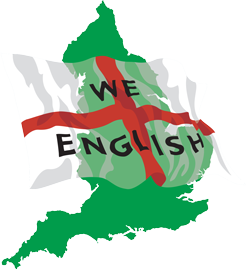We English will be signed off this week and I’ll be heading to Verona at the end of the month to oversee the printing, along with the publisher Chris Boot. As I’ve mentioned before, the book is being designed by Damon Murray and Stephen Sorrell at Fuel, who we worked with on Motherland. Here’s a sneak preview of their fantastic design for the cover:
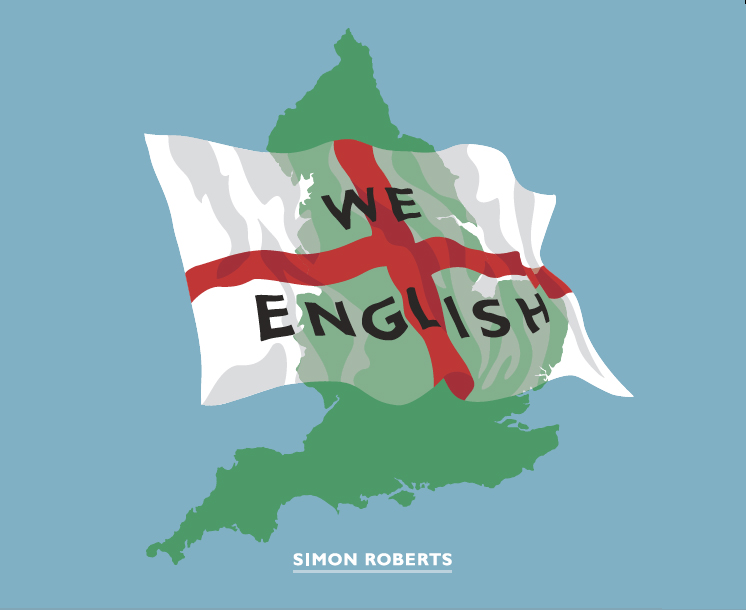
Posted in POST PRODUCTION | 7 Comments »
For the second year running I have two framed pieces included in the Royal Academy Summer Exhibition in London. ‘Taxis cross the frozen Lena river, Yakutsk’ 2004 (40×30″) and ‘Lounge of former sanitorium, Sludyanka’ 2005 (40×30″), both from my Motherland series, are on display at the RA from 8 June – 16 August.
The Summer Exhibition is the largest open submission contemporary art exhibition in the world, drawing together a wide range of new work by both established and unknown living artists. In its 241st year, it includes around 1200 works and this year’s exhibition coordinators are Royal Academicians Will Alsop, Ann Christopher and Eileen Cooper. The theme this year is Making Space.
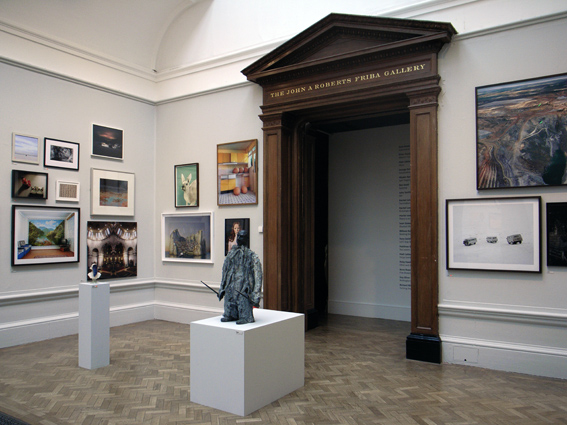
© John Roberts, 2009
My photographs appear in the John A. Roberts Friba Gallery, which was hung by Richard Wilson and Eileen Cooper, and can be seen in the installation photograph above (on the bottom left and bottom right of the image). Thanks to my Dad for taking the photographs and who, by the way, is no relation of John A. Roberts, the retired international Architect and a Fellow of The Royal Institute of British Architects (FRIBA)!
The room is largely devoted to photographic work and as the introductory wall text explains “In the old days, reactionary opinion would have been horrified at the presumptuous advent of photography in the hallowed portals of the Royal Academy. But now it seems absolutely right to acknowledge the forceful presence of photographic media in art practice.”
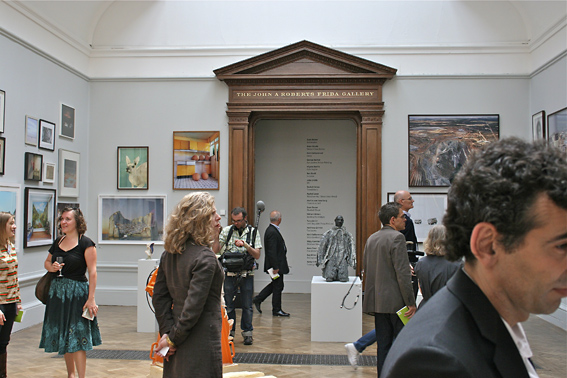
© John Roberts, 2009
Much like strawberries at Wimbledon, the Summer Exhibition is an annual fixture on London’s social calendar, with visitors flocking to see the works of both professional and amateur artists, while sipping on Pimms. This is especially true of Buyers’ Day where the atmosphere is convivial but competitive, as people jostle to see the exhibits, while also trying to pick up a bargain (I was thrilled to discover an orange dot under one of my pictures!).
The exhibition is loved and hated in equal measure, and is amusingly described in an article in The Times this week as “the art world’s annual jumble sale: you can pick up anything from a vast canvas by a venerable Royal Academician to a tiny print by some talented amateur.”
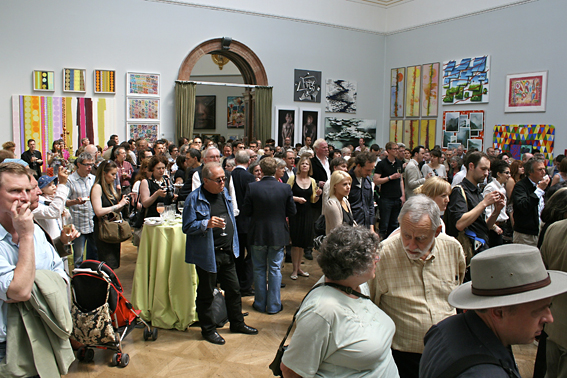
© John Roberts, 2009
The idea of an art exhibition as a spectator sport brings me nicely on to the Derby Day at Epsom Racecourse, another hugely popular event on the social calendar, which took place last Saturday. As discussed previously on the blog, the Epsom Derby was famously portrayed in oil on canvas by William Powell Frith in his painting The Derby Day (1856-8). The painting of the crowds at Epsom on Derby Day itself drew crowds to the exhibtion room at the Royal Academy in 1858 and proved so popular that rail had to be put up to keep back the crowds.
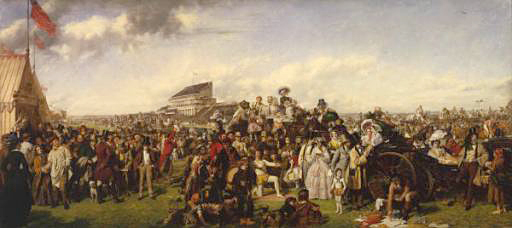
William Powell Frith, The Derby Day (1856-8). Oil on canvas.
The Derby is considered one of the most prestigious flat thoroughbred horse races in the world. The first recorded race took place in 1661. For spectators, the Derby has long been known for its unique party atmosphere and for the full range of social classes on view. Tens of thousands of people flock to a public area known as The Hill, where entry to the centre of the course is free. You could say that this photograph, which will appear in the book, is my attempt at replicating Frith’s wonderfully satirical painting-
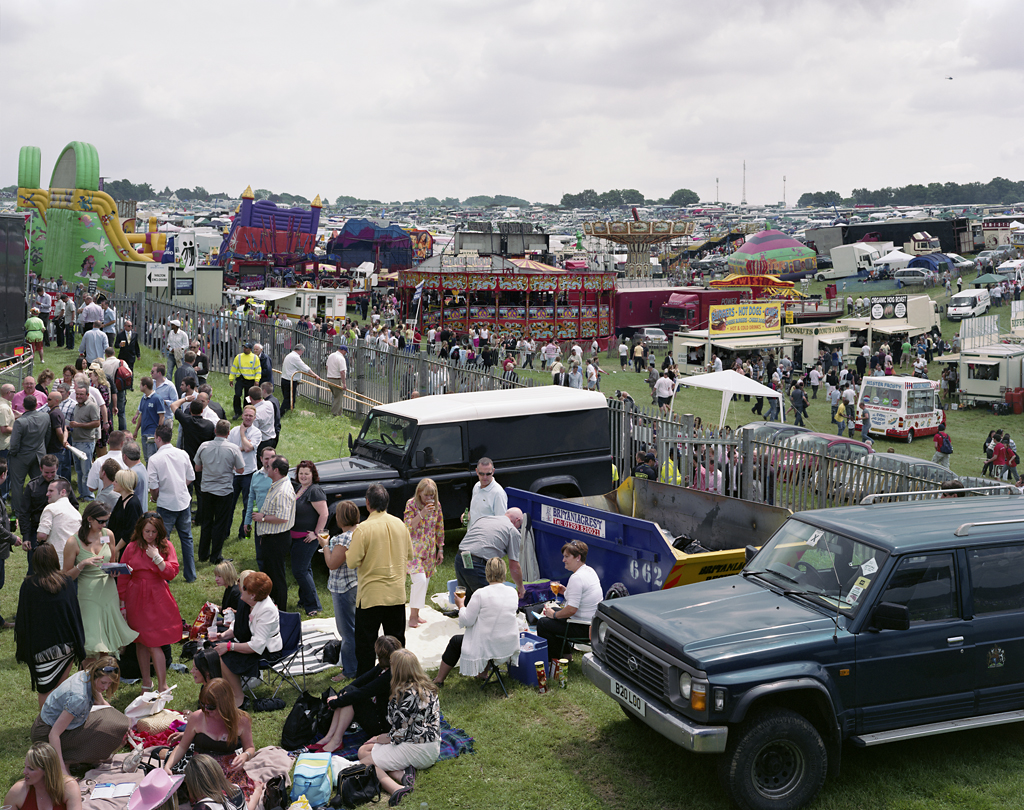
Derby Day, Epsom Downs Racecourse, Surrey, 7th June 2008 © Simon Roberts
Posted in EVENTS & PASTIMES | 1 Comment »
Graduation season is upon us once again, when a slew of new photographers will be leaving BA and MA courses from across the country. One such graduate, Andy Greaves, who has recently completed the MA Photography course at De Montfort University in Leicester, was kind enough to get in touch recently with details of his final thesis. Greaves has produced a series of portraits around the theme of English identity.
Here’s a short commentary about his ‘England My England’ project with a selection of photographs.
“After careful consideration I am driven to the conclusion that my ‘English’ identity is deep within me, symbolically at my own front door. That my own identity and that of being English is as much shaped by my own personal history as it is by the Englishness defined by any academic notions of the subject; the country’s aspects of climate, social, political and cultural history. To ignore our own personal history is to ignore not just an essential part of who we are as individuals but what makes us all collectively English. I do not deny that English nationalism exists but it is similarly difficult to deny that the nation state is not constructed by those it best profits: the politicians, the Established order, the monarchy, and the Church. Furthermore that national identity is both multi faceted and continuously shifting. If I sound cynical and ambivalent it is because my own personal experiences, readings and education have ingrained within me this opinion.”
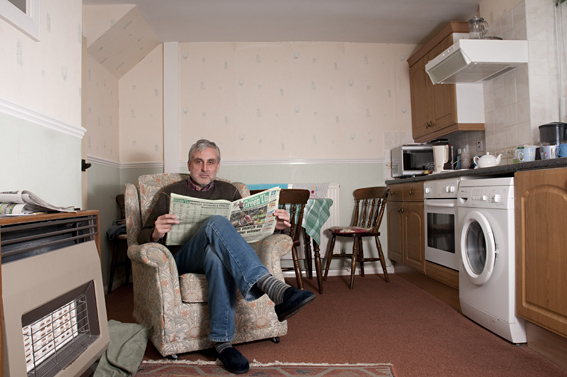
Brian © Andy Greaves, 2008
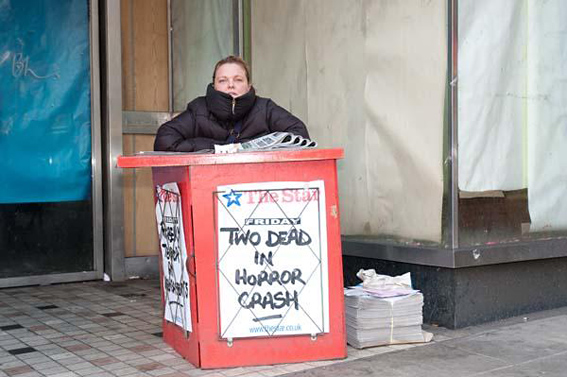
Vendor © Andy Greaves, 2008
“As photographers we are often outsiders looking in and therefore only expected to respond visually to what is in front of us backed up by the necessary research. During this project I have felt the burden of being on the inside looking out, having to consider those aspects of Englishness, the mass of cultural, historical, political baggage that an Englishman would necessarily take for granted and an outsider would be unaware of.”
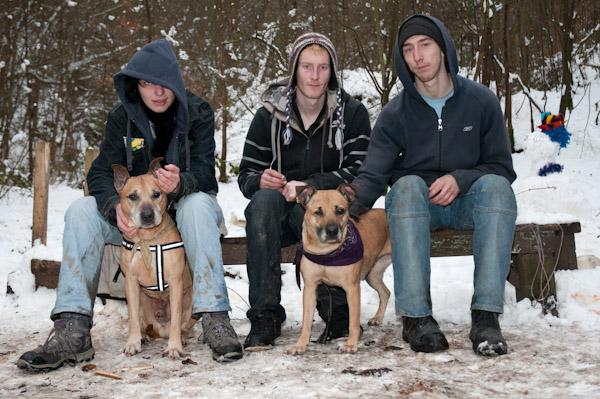
Elizabeth, Alan and Karl © Andy Greaves, 2008
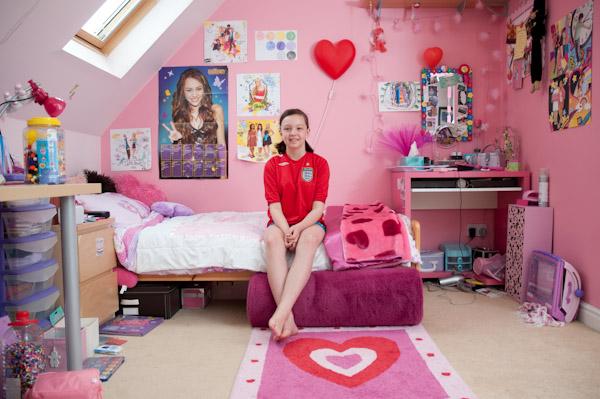
Emily © Andy Greaves, 2008
“My series of images attempt to capture my feelings towards my nationality, a personal reflection of Englishness. Essentially of friends, family and close acquaintances they attempt to show a quintessential Englishness. They are of people who in many ways have shaped and represent my current thinking on Englishness.”
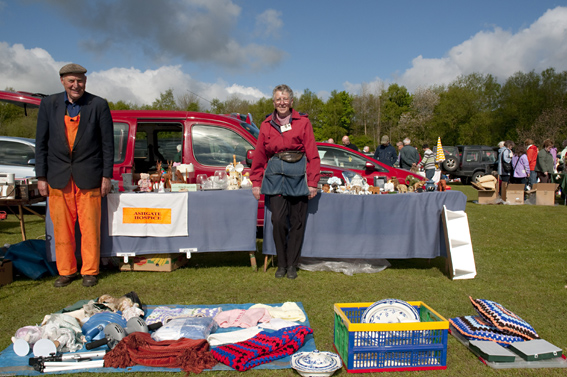
Annie and Andrew © Andy Greaves, 2008
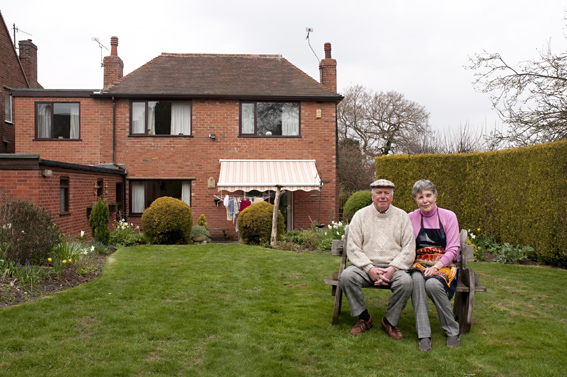
Mum and Dad © Andy Greaves, 2008
You can see the entire series on Greaves’ website here.
Posted in OTHER STUDIES | Comments Off on ENGLAND MY ENGLAND PORTRAITS
Today is Whitsun so what better way to celebrate than Philip Larkin’s beautiful poem, ‘The Whitsun Weddings’.
In the poem Philip Larkin describes his stopping-train journey through East Yorkshire from Paragon Station, Kingston upon Hull to Kings Cross, London on a hot and humid Whitsun Saturday afternoon in 1955. Larkin through his simple, yet elegant style divulges the details of a commonplace journey into a wonderful poem.
The Whitsun Weddings by Philip Larkin, 1958
That Whitsun, I was late getting away:
Not till about
One-twenty on the sunlit Saturday
Did my three-quarters-empty train pull out,
All windows down, all cushions hot, all sense
Of being in a hurry gone. We ran
Behind the backs of houses, crossed a street
Of blinding windscreens, smelt the fish-dock; thence
The river's level drifting breadth began,
Where sky and Lincolnshire and water meet.
All afternoon, through the tall heat that slept
For miles inland,
A slow and stopping curve southwards we kept.
Wide farms went by, short-shadowed cattle, and
Canals with floatings of industrial froth;
A hothouse flashed uniquely: hedges dipped
And rose: and now and then a smell of grass
Displaced the reek of buttoned carriage-cloth
Until the next town, new and nondescript,
Approached with acres of dismantled cars.
At first, I didn't notice what a noise
The weddings made
Each station that we stopped at: sun destroys
The interest of what's happening in the shade,
And down the long cool platforms whoops and skirls
I took for porters larking with the mails,
And went on reading. Once we started, though,
We passed them, grinning and pomaded, girls
In parodies of fashion, heels and veils,
All posed irresolutely, watching us go,
As if out on the end of an event
Waving goodbye
To something that survived it. Struck, I leant
More promptly out next time, more curiously,
And saw it all again in different terms:
The fathers with broad belts under their suits
And seamy foreheads; mothers loud and fat;
An uncle shouting smut; and then the perms,
The nylon gloves and jewellery-substitutes,
The lemons, mauves, and olive-ochres that
Marked off the girls unreally from the rest.
Yes, from cafés
And banquet-halls up yards, and bunting-dressed
Coach-party annexes, the wedding-days
Were coming to an end. All down the line
Fresh couples climbed aboard: the rest stood round;
The last confetti and advice were thrown,
And, as we moved, each face seemed to define
Just what it saw departing: children frowned
At something dull; fathers had never known
Success so huge and wholly farcical;
The women shared
The secret like a happy funeral;
While girls, gripping their handbags tighter, stared
At a religious wounding. Free at last,
And loaded with the sum of all they saw,
We hurried towards London, shuffling gouts of steam.
Now fields were building-plots, and poplars cast
Long shadows over major roads, and for
Some fifty minutes, that in time would seem
Just long enough to settle hats and say
I nearly died,
A dozen marriages got under way.
They watched the landscape, sitting side by side
- An Odeon went past, a cooling tower, And
someone running up to bowl - and none
Thought of the others they would never meet
Or how their lives would all contain this hour.
I thought of London spread out in the sun,
Its postal districts packed like squares of wheat:
There we were aimed. And as we raced across
Bright knots of rail
Past standing Pullmans, walls of blackened moss
Came close, and it was nearly done, this frail
Travelling coincidence; and what it held
stood ready to be loosed with all the power
That being changed can give. We slowed again,
And as the tightened brakes took hold, there swelled
A sense of falling, like an arrow-shower
Sent out of sight, somewhere becoming rain.
© from The Collected Poems (Faber, 1993), by permission of the publisher, Faber & Faber Ltd.
You can hear an audio clip of him reading the poem here.
In 1981, more than a quarter of a century after writing ‘The Whitsun Weddings’, Larkin recalls the genius of his poem-
“I caught a very slow train that stopped at every station and I hadn’t realised that, of course, this was the train that all the wedding couples would get on and go to London for their honeymoon: it was an eye-opener to me. Every part was different but the same somehow. They all looked different but they were all doing the same things and sort of feeling the same things. I suppose the train stopped at about four, five, six stations between Hull and London and there was a sense of gathering emotional momentum. Every time you stopped fresh emotion climbed aboard. And finally between Peterborough and London when you hurtle on, you felt the whole thing was being aimed like a bullet – at the heart of things, you know. All this fresh, open life. Incredible experience. I’ve never forgotten it.”
Posted in INSPIRATION | Comments Off on PHILIP LARKIN, THE WHITSUN WEDDINGS
I recently visited the Towner Art Gallery in Eastbourne, which opened on April 4th after relocating to a wonderful new building designed by Rick Mather Architects, having outgrown their original building. It’s well worth a visit. In the main space they’re currently exhibiting work by Ivan Navarro – sinister anthropomorphic neon relief sculptures, based on the Olympic pictograms designed by Otl Aicher in 1972.
The gallery first opened in 1923 and curator Arthur Reeves Fowkes was appointed to oversee the expansion of the collection. Under his leadership, a ‘Pictures of Sussex’ policy was developed. The Corporation of Eastbourne funded the acquisition of paintings of the local landscape, ‘in order to provide the visitor with a complete review of this beautiful country.’ An unrivalled collection of paintings, drawings and watercolours was gradually accumulated. The first floor of the new gallery is devoted to pieces from this permanent collection. It includes work by the renowned English painter Eric Ravilious (father of James Ravilious, the photographer whose work I discussed on the blog here).
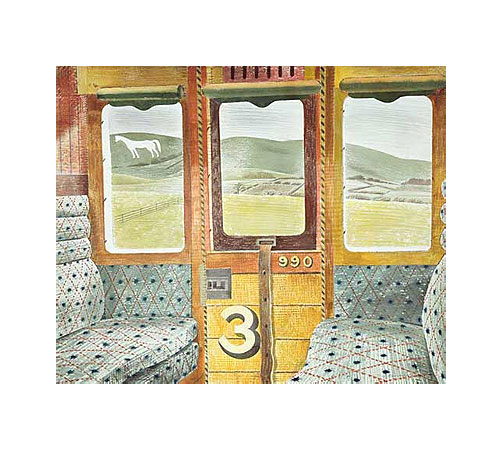
Train Landscape, 1939 © Estate of Eric Ravilious/ Prints of this image can be obtained from Book Room Art Press
Ravilious studied at Eastbourne School of Art, and at the Royal College of Art, He began his working life as a muralist, first coming to notice as an artist in 1924. He went on to become one of the best-known artists of the 1930s including working as an Official War Artist during the Second World War. He was killed on active service.
A retrospective of his work called Imagined Realities at the Imperial War Museum in 2003, examined Ravilious’s contribution to British cultural life between the Wars and during the first years of the Second World War. As John Russell Taylor wrote in The Times, “Ravilious shines out for his distinctive vision, at once suspicious of and enthralled by the romantic spectacle associated with war. And curiously, this romantic duality proves to be right at the heart of a traditional, non-chauvinistic sort of Englishness. Englishness is, for once, the word….he was English to his deepest roots, and was turned on as an artist exclusively by the English scene, the sweep of English history, the little eccentric details of English life.”
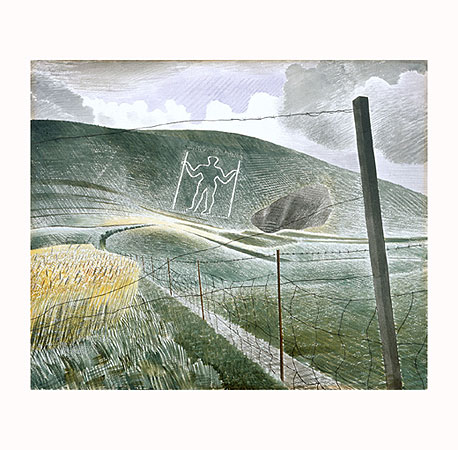
The Wilmington Giant, 1939 © Estate of Eric Ravilious/ Prints of this image can be obtained from Book Room Art Press
Some of Ravilious’s most deeply imagined Spirit-of-England work is connected with the ancient chalk figures inscribed on southern hills, such as The Wilmington Giant and The Westbury Horse.
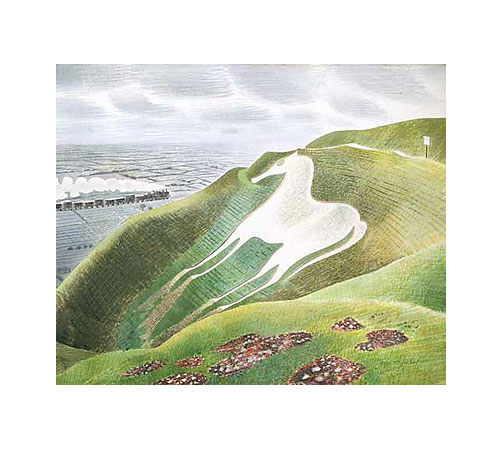
The Wesbury Horse, 1939 © Estate of Eric Ravilious/ Prints of this image can be obtained from Book Room Art Press
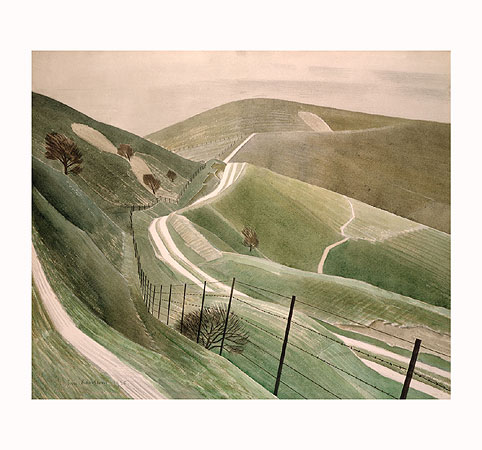
Chalk Paths, 1935. © Estate of Eric Ravilious/ Prints of this image can be obtained from Book Room Art Press
“In his watercolours, he observed and recorded the relationship between the modern world and the English landscape in a style that was both formal and yet deeply felt. His work as a designer helped to define traditions of English culture of the period.”
There is an extenstive discussion of Ravilious work on the Imperial War Museum website here.
Prints of Ravilious’ images can be obtained from The Kemp Town Bookshop, Brighton, Tel: 01273-682110.
Posted in MISCELLANEOUS | Comments Off on ERIC RAVILIOUS
As I’ve mentioned a few times on the blog, this is an exciting time for photographers documenting England (and long overdue). One photographer mid-way through a journey around the country is John Angerson, whose pictures I posted up on an earlier blog post here. I emailed Angerson a few questions about his project which he’s been kind enough to answer below.
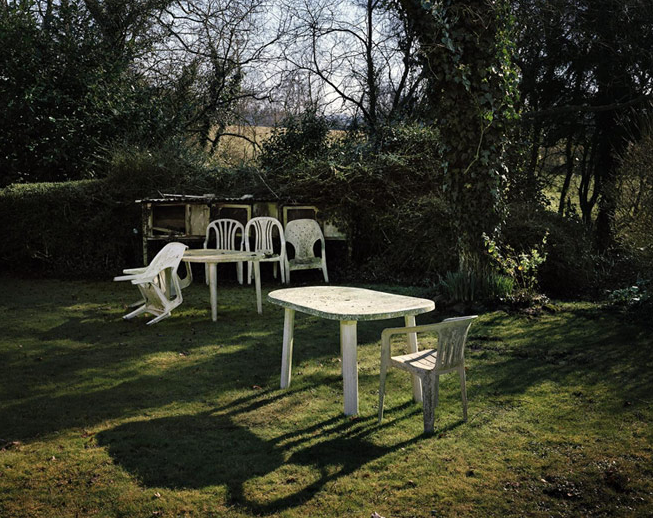
Newport Inn Public House, Braishfield, Southampton © John Angerson, 2008
Why have you chosen to follow in the footsteps of JB Priestley? What is it about his book that you associate with, instead for example, with H.V.Morton’s ‘In Search of England’ or George Orwell’s The Road To Wigan Pier?
I first read ‘English Journey’ in 1990 and within the first couple of pages I was hooked. I greatly enjoy Priestley’s writing style and as I spent a large portion of my photographic career living and working in his hometown; Bradford, Yorkshire, I feel an affinity with his views and sentiment on England. Priestley was unique in combining a warm humanity with searing social insight. His writings on the people and places he encountered give us perhaps the most vivid and enduring impression of the country at this pivotal period; and the England Priestley discovered in 1933 is both alien and strangely familiar. This year marks the 75th anniversary of the book and it seemed to me to be the right time to undertake a project that references this signifcant literature.
Will you be re-visiting the places Priestley visited? Are you making a continuous journey around England? How are you traveling? (Priestley seemed to take all manner of transportation).
I am following the trail Priestley took in 1933 and have researched each geographical location he covered in his book. I have spread the project over the last year choosing to visit two to three locations in each trip. I have been using the same modes of transport as he did: a combination of train, motorcar and coach.
How would you describe the photographic approach to your work? I notice from your initial photographs that you are bringing together landscapes, portraiture and interiors.
For this project my approach is to produce quiet, contemplative images of England in its urban and rural landscape and its inhabitants – images that will sit comfortably alongside Priestley’s text.
How important an element to the project is portraiture? (In Priestley’s view, rooted in nineteenth-century radicalism, it is ‘the people’ who are the real nation). And how do you decide who you will photograph- random people you come across or do you have a mental list of types of people you’re looking for?
I have been taking photographs in each location in response to what and who I encounter now and what Priestley wrote about in his book then. I am aiming to capture the essence of an English Journey rather than create a modern literal version. I’ve always tried to use an opportunistic approach when shooting my projects. I have spent a great deal of time trying to research and locate contemporary people and places that Priestley would have been interested in talking to and seeing if he were experiencing England in 2009. This has ranged from office workers, Big Brother contestants and mothers of fallen soldiers from the Iraq war. As with many of my other long term projects I am very interested and drawn towards inter-dependent groups within communities. I believe that Priestley’s English Journey overwhelmingly articulated the need for England to remove itself of illusions and that people must depend upon each other and work as individuals towards a common purpose.
There are interesting parallels with Preistley’s work which was produced during an economic slump, and his work was overtly political, appealing for democratic socialist change. You are also producing your series during quite a serious economic downturn, do you considered this important/relevant? Will their be a political stance to your series?
I started this project before the current economic slump, and I have noticed that as I have travelled, more of the images have had an element of the recession; be it subtle or the main image component. It has been said that Priestley’s writing helped shape Beveridge’s 1942 report and the great reforming Labour government of 1945. After the publication of English Journey in 1934 many leading figures in Mass Observation and the documentary movement were influenced by the book and ventured into the English industrial heartlands to record for themselves this included – Ellen Wilkinson, James Hanley and most notably George Orwell in The Road to Wigan pier two years after English Journey in 1937.
Why did you decide to make a transition to 5×4 (and colour) after your last book, ‘Love, Power and Sacrifice’?
Lover Power and Sacrifice was shot over 20 years on a 35mm. For English Journey I felt a change of approach would challenge me as a photographer. Due to it’s cumbersome size and single-shot nature the 5×4 camera forces the user to think harder about subject and composition; helping me to spend more time thinking and creating quiet contemplative photographs. As the images are a modern take on the English Journey book it seemed natural to shoot colour film.
As I’m sure you’re aware, there is a rich history of British photographers documenting their homeland. Whose work in this tradition do you most admire and why?
I greatly admire the work of British photographer Bill Brandt. There is a superb quote by Photographer, Bill Jay, which really sums up his work:
“Bill Brandt was a quiet, withdrawn, priest-like character with the taut skin and bony, elegant features of an aristocratic aesthete. He spoke sparsely and in little more than a whisper. He believed that the camera was a medium through which he received messages from another world. I am just beginning to understand what he meant. Brandt was other-worldly in another sense. Aloof from trends and movements in his own medium, he seemed to know nothing and no one in contemporary photography. He quietly continued his experiments, always thrusting ahead into new directions, confounding expectations and confusing his critics.”
Are you worried about your photographs being derivative of previous photographic studies of England?
Photographs are subjective – documentary photography can only ever be about the photographer’s perceptions of place, time and the people they encounter. As Priestley said, this will be “What one man saw and heard and felt on an English Journey.”
How are you funding the project?
I have been awarded a bursary from the Arts Council England for the project.
What do you see as the finished product?
A traveling exhibition with an accompanying book in 2010
Posted in OTHER STUDIES | Comments Off on JOHN ANGERSON INTERVIEW
I recently received the first proofs from the printers in Italy (we’ll be printing the book at EBS in Verona) and they’re looking great. It’s wonderful to get a glimpse of what the photographs are going to look like on the printed page, especially at this scale – the book’s going to be more of an ‘album’ than Motherland, sized at 36x29cm.
Checking reproduction quality of the book prints (left) with my colour match prints (right)-
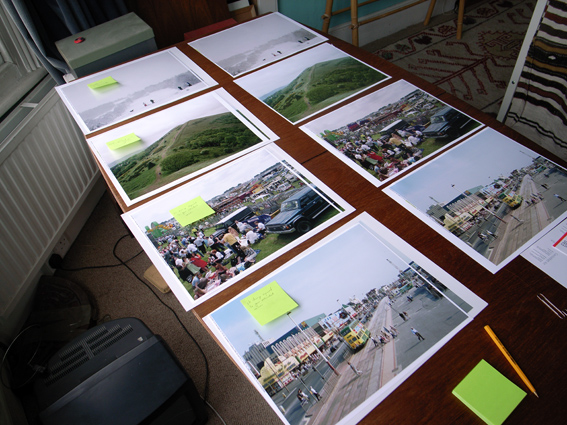
The printing presses have now been booked for the end of June so deadlines are looming to finish the text and produce the CMYK scans and remaining match prints.
Accordingly, I spent the past week holed up in the darkroom of the colour printer, Rob Sara, tucked away in a Lakeland stone building near Burton-in-Kendal. Rob is a master printer, and I don’t say that lightly. He ran Rapid Eye’s printing service in Shoreditch for years, before making the jump and starting out on his own, opening the Studio One Darkroom in the beautiful surroundings of the southern Lake District. He’s produced prints for the likes of Hannah Starkey, Stephen Gill, Johnathon de Villiers and Cedric Buchet that have been exhibited in public and private collections around the world, including the Museum of Modern Art in New York, National Portrait Gallery, Tate Modern and Rencontre d`Arles
Having exclusively produced digital C-type prints for the past few years, I decided this time around, I wanted to get a set of traditional C-type hand prints made for the We English book production.
It was a wonderful experience working alongside Rob, who was able to get the most out of each negative-
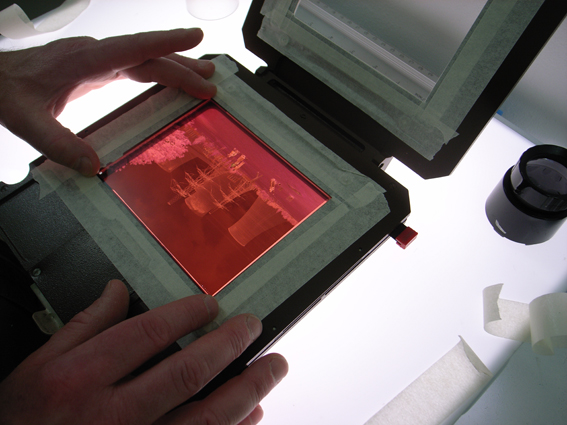
And produce some luminous prints-
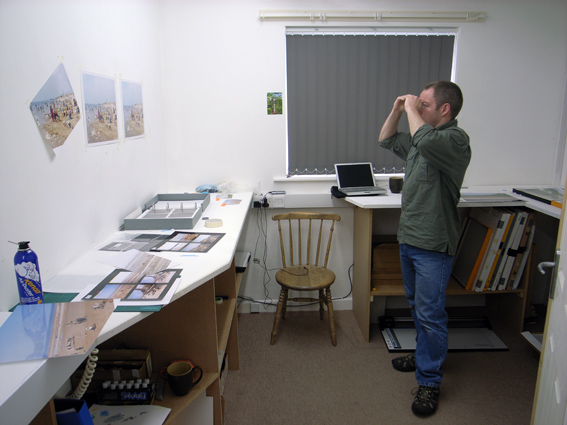
However, the week left me totally exhausted!
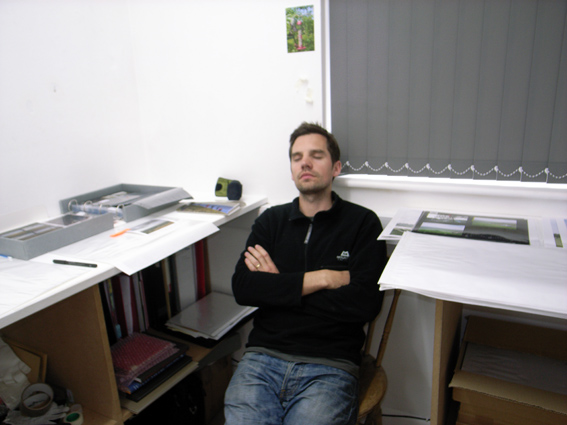
It’s now back to Brighton to do the CMYK conversions and finish the text. More of that later.
Posted in POST PRODUCTION | Comments Off on PRODUCTION UPDATE
“Once upon a time I lived in a double-decker bus, reg. JRR 404, better known as the Free Photographic Omnibus. She was my home, my travelling darkroom and gallery” writes Daniel Meadows on his Photobus website.
“People ask: “Where are you from?” and I have to tell them that really I don’t know. What I do know is that I’m English. And this story is about the England I come from.
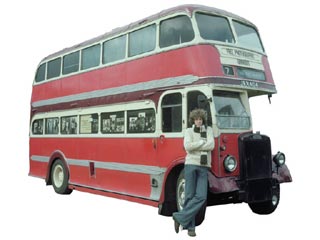
We were an unlikely couple; she with her crash gear box and temperamental ways, me with my bushy hair and homemade flares. But we got along okay and, during 1973 and ’74, we travelled about making a national portrait of the English. We covered 10,000 miles shooting pictures and giving them away. The bus’s glory days, taking holiday-makers on seaside runs to Skegness and Mablethorpe, were in the 1950s but, by the time I got to know her, she was 25 years old and (it has to be said) past her best. By comparison I — fresh out of art school and all of four years her junior — was just a whipper-snapper.”
Photographer and university lecturer Daniel Meadows is recognised as one of the prime movers in the new documentary photography movement of 1970s Britain and is best known of his tour around England in the Free Photographic Omnibus (1973-74).
In 1973 – just out of Art School – Meadows bought a double-decker bus and spent 14 months travelling through English towns. When he pulled up, he took free portraits of people who came to his bus which was fitted out as a mini-studio. In the course of a 14-month journey, he offered free portrait sessions in 22 different towns, developing the black and white prints in a darkroom he had contrived inside the bus, in which he also lived. He photographed a total of 958 people, alone or in groups, the majority of whom remained anonymous and collected their free portraits the following day.
The result was a series of photographs he called ‘National Portraits’, a selection of which you can see here-
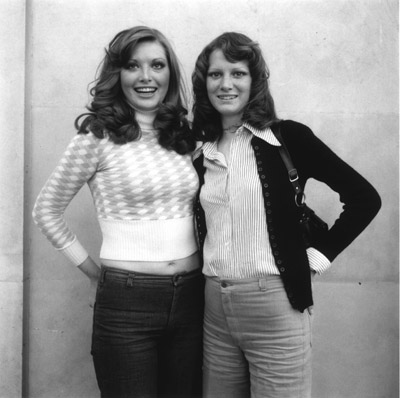
Lyn & Stella Brasher, Sisters, Southampton © Daniel Meadows, 1974
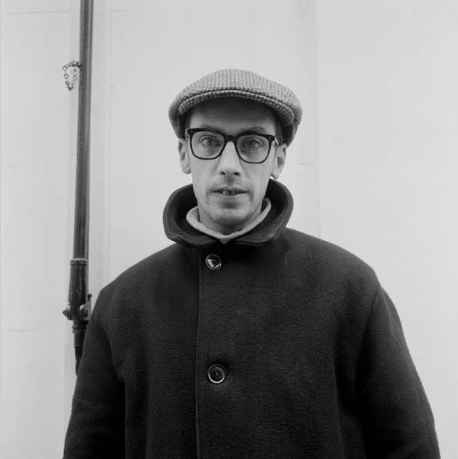
© Daniel Meadows, 1974
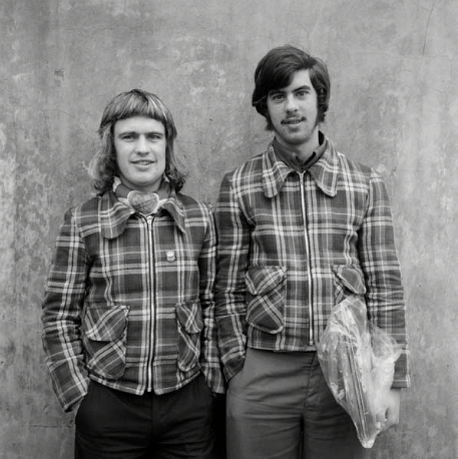
© Daniel Meadows, 1974
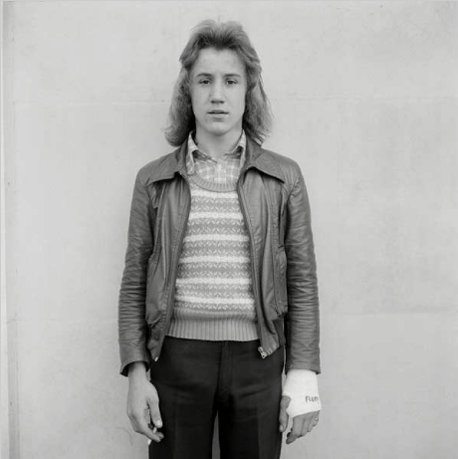
© Daniel Meadows, 1974
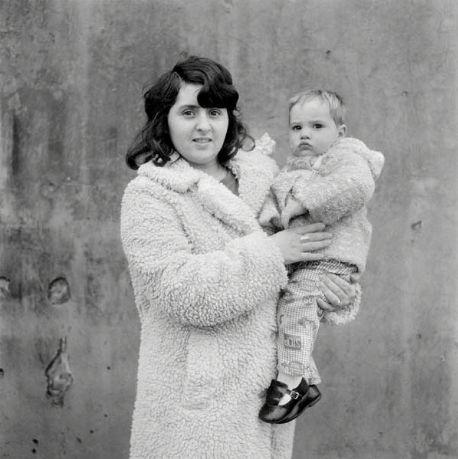
© Daniel Meadows, 1974
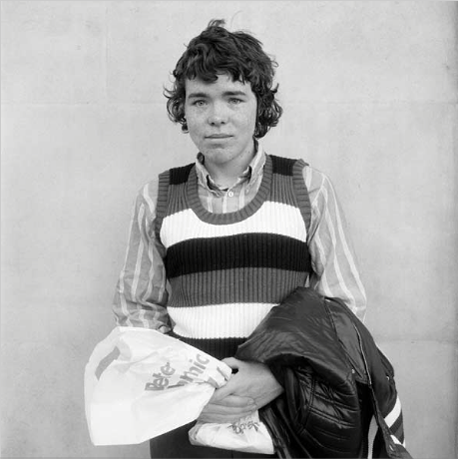
© Daniel Meadows, 1974
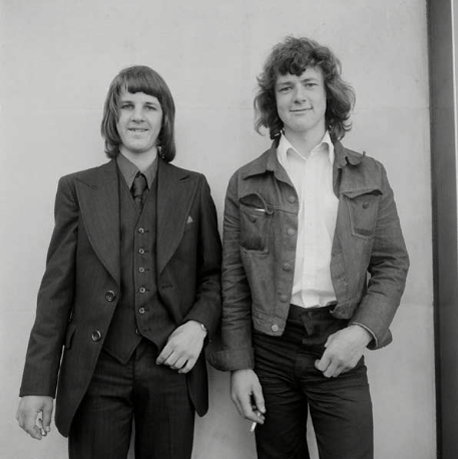
© Daniel Meadows, 1974
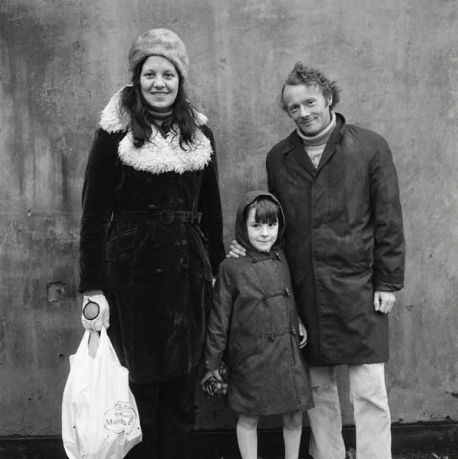
© Daniel Meadows, 1974
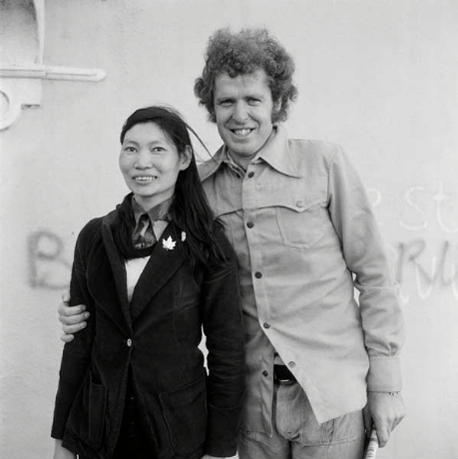
© Daniel Meadows, 1974
You can view a slideshow with more images from the series on Meadows’ website here.
In 1999Â Meadows decided to ‘go back’ and re-photograph some of his original ‘subjects’. He ‘found’ them by putting original photographs in local papers. The two series of portraits (from 1974 and 1999) were then published alongside each other in a book called The Bus: The Free Photographic Omnibus 1973-2001 (The Harvill Press, London, 2001).
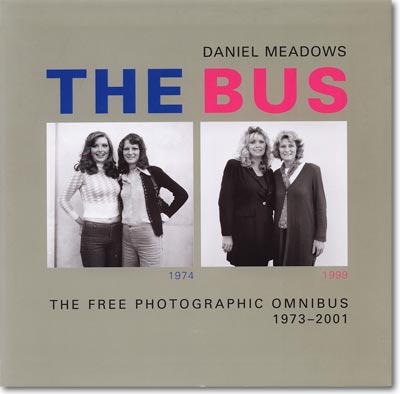
With the help of the local press in Barrow-in-Furness, Hartlepool and Southampton, he went in search of them. Many could not be found, others had died, but a number of people turned up to be re-photographed. The juxtaposition of their past and present selves makes for a unique pictorial history of the changing face of England (particularly the vagaries of fashion, and the ravages of time). Meadows interviews the sitters, ordinary people from varied walks of life, who talk candidly about their lives, their friends, their loves, their families and what they feel.
You can take multi-media tour on Meadows’ bus here.
Posted in ENGLISHNESS, OTHER STUDIES | 2 Comments »
I’ve just come across details of an intriguing new book published by Dewis Lewis called In A Very English Town. John Comino-James has photographed the streets, shops and shopkeepers in the centre of Thame, an historic market town some 45 miles from London. Comino-James studied his local town after being asked by a Cuban friend to show her life in his area. His series of panoramic photographs were taken between July 2007 – June 2008 and are laid out in the book in a sequence representing a meandering walk through the town.
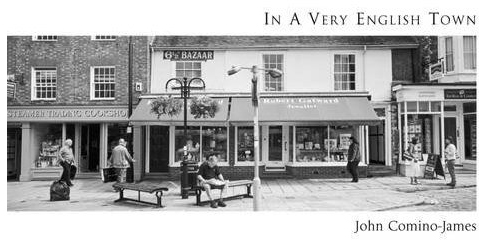
£19.99
Hardback, 168 pages
110 duotone photographs
160mm x 295mm
Here are the publishers notes on the book-
“High Street, Buttermarket, Cornmarket, Pump Lane, North Street, Park Street, have such a deceptive familiarity to the English ear that they might be found in any English town. They are names that suggest a sense of continuity and tradition – something very English. Yet the reality is often not quite what it appears.
Portraits, texts and candid photographs which document everything from the last cattle market operating in the area, travelling showmen at one of the two annual fairs, and the weekly street market. The accompanying interviews reveal pride in the continuation of family businesses, as well as small enterprises both challenged by and benefiting from the increasing impact of the internet.
While the presence of supermarkets and services such as banks, travel agents and estate agents is acknowledged, in choosing subjects for portraits Comino-James was drawn to those shopkeepers whose aim might be summed up in the words of one of them: ‘To keep the character of Thame as a Market Town and not a Supermarket town’.”
You can see a slideshow of photographs on the Guardian website here.
Posted in OTHER STUDIES | Comments Off on IN A VERY ENGLISH TOWN
There’s an article by Paul Lowe on the Foto 8 blog where he writes about this year’s World Press Photo Awards. You can read it here.
Lowe quotes the outgoing chairman of the awards (and director of VII photo agency), Stephen Mayes-
“…ccommentating that 90% of the pictures submitted were about 10% of the world, he questioned why most photojournalism investigates a very limited series of tropes in a very limited series of visual approaches, becoming a self replicating machine that churns of copies of itself in perpetual motion, which he described as a ‘feeling that photojournalism, rather than trying to reinvent itself its trying to copy itself ‘, and that the industry is in essence reactionary and unrealistic in its understanding of the changes in global media and society.  Too many photographers are ‘reflecting the media not as it is but as we wish it was’ and assuming that it is the world that must come to them, not they that must go to the world. Bemoaning the surfeit of stories about the ‘Dispossessed and powerless, the exotic and anywhere but home’ he encouraged photographers to ‘photograph what really, really intrigues you’.”
Posted in MISCELLANEOUS | Comments Off on ANYWHERE BUT HOME

